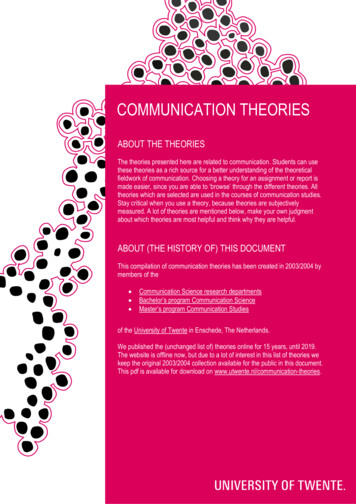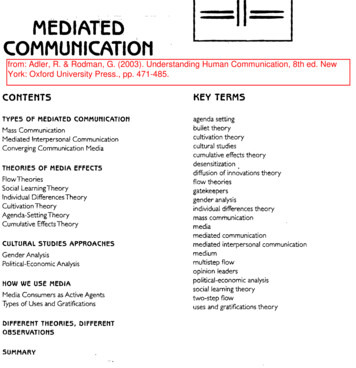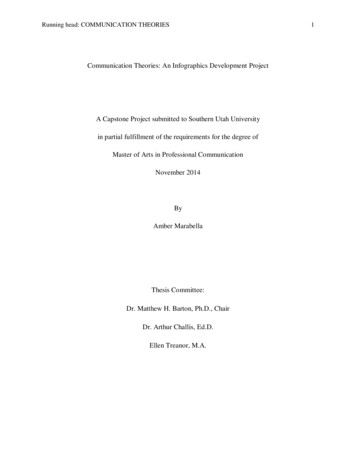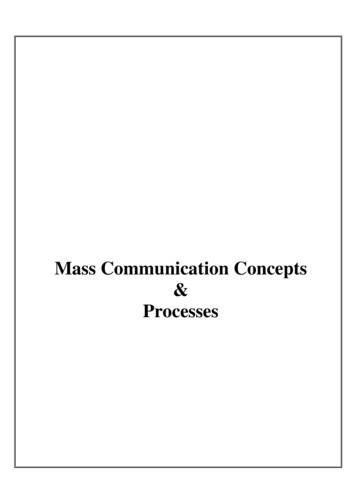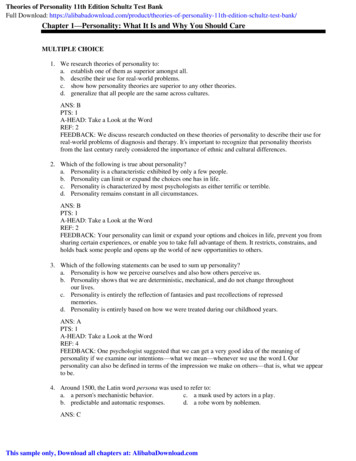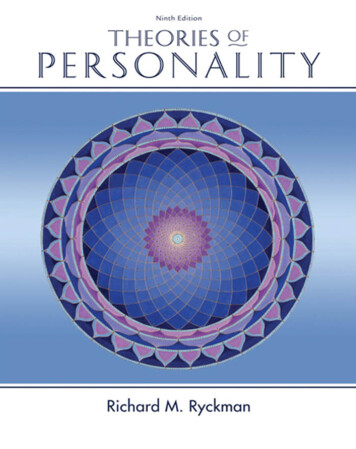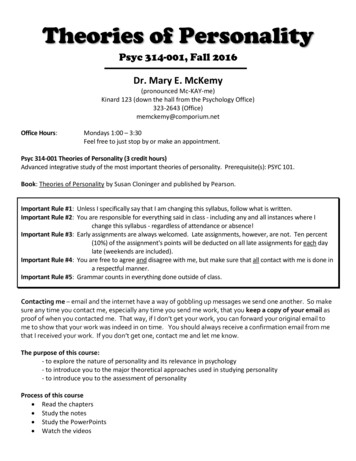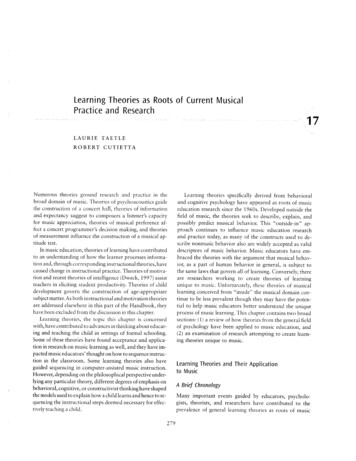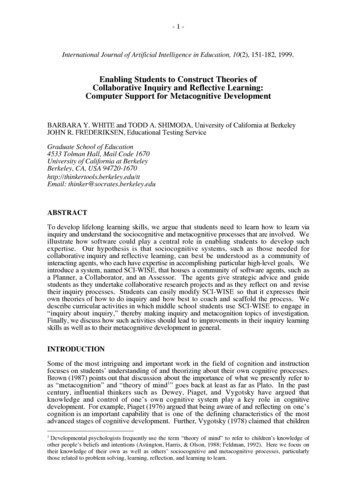
Transcription
-1-International Journal of Artificial Intelligence in Education, 10(2), 151-182, 1999.Enabling Students to Construct Theories ofCollaborative Inquiry and Reflective Learning:Computer Support for Metacognitive DevelopmentBARBARA Y. WHITE and TODD A. SHIMODA, University of California at BerkeleyJOHN R. FREDERIKSEN, Educational Testing ServiceGraduate School of Education4533 Tolman Hall, Mail Code 1670University of California at BerkeleyBerkeley, CA, USA : thinker@socrates.berkeley.eduABSTRACTTo develop lifelong learning skills, we argue that students need to learn how to learn viainquiry and understand the sociocognitive and metacognitive processes that are involved. Weillustrate how software could play a central role in enabling students to develop suchexpertise. Our hypothesis is that sociocognitive systems, such as those needed forcollaborative inquiry and reflective learning, can best be understood as a community ofinteracting agents, who each have expertise in accomplishing particular high-level goals. Weintroduce a system, named SCI-WISE, that houses a community of software agents, such asa Planner, a Collaborator, and an Assessor. The agents give strategic advice and guidestudents as they undertake collaborative research projects and as they reflect on and revisetheir inquiry processes. Students can easily modify SCI-WISE so that it expresses theirown theories of how to do inquiry and how best to coach and scaffold the process. Wedescribe curricular activities in which middle school students use SCI-WISE to engage in“inquiry about inquiry,” thereby making inquiry and metacognition topics of investigation.Finally, we discuss how such activities should lead to improvements in their inquiry learningskills as well as to their metacognitive development in general.INTRODUCTIONSome of the most intriguing and important work in the field of cognition and instructionfocuses on students’ understanding of and theorizing about their own cognitive processes.Brown (1987) points out that discussion about the importance of what we presently refer toas “metacognition” and “theory of mind1 ” goes back at least as far as Plato. In the pastcentury, influential thinkers such as Dewey, Piaget, and Vygotsky have argued thatknowledge and control of one’s own cognitive system play a key role in cognitivedevelopment. For example, Piaget (1976) argued that being aware of and reflecting on one’scognition is an important capability that is one of the defining characteristics of the mostadvanced stages of cognitive development. Further, Vygotsky (1978) claimed that children1Developmental psychologists frequently use the term “theory of mind” to refer to children’s knowledge ofother people’s beliefs and intentions (Astington, Harris, & Olson, 1988; Feldman, 1992). Here we focus ontheir knowledge of their own as well as others’ sociocognitive and metacognitive processes, particularlythose related to problem solving, learning, reflection, and learning to learn.
-2progress from relying on others, such as teachers, to help regulate their cognition to beingable to regulate it themselves, having internalized the regulation and control skills modeled byothers.Recent research adds additional theoretical and empirical support to arguments regardingthe important role that metacognition plays in students’ academic performance and cognitivedevelopment (e.g., Baird, Fensham, Gunstone, & White, 1991; Chi, Bassock, Lewis,Reimann, & Glaser, 1989; Schauble & Glaser, 1990; Schoenfeld, 1987). Our own work, forexample, indicates that enabling students to develop metacognitive expertise plays a majorrole in facilitating inquiry learning, particularly for academically disadvantaged students(White & Frederiksen, 1998). In addition, certain types of social interactions and activities,such as collaborative work and peer tutoring, have been shown to facilitate learning anddevelopment (e.g., Brown & Palincsar, 1989; Driver et. al., 1994; Okada & Simon, 1997;Slavin, 1995), as have social structures introduced to create classroom communities thatembody social constructivist approaches to learning (e.g., Bielaczyc & Collins, in press;Brown & Campione, 1996; Palincsar & Brown, 1989). Such findings support the view thatsocial processes as well as cognitive processes play a major role in students’ academicperformance and cognitive development (Damon, 1990; Vygotsky 1978; Wertsch, 1991).The above considerations lead us to a broad view of metacognition that encompasses: (1)“knowledge about knowledge,” including knowledge of the form and content of cognitiveand social expertise and when and why such expertise is useful; (2) “regulatory skills,”including skills needed to employ sociocognitive expertise, such as planning and monitoringskills; and (3) “development expertise,” including the ability to reflect on sociocognitiveknowledge and its use to determine how to modify and improve both of these.Given its importance, how can we enable young students to develop such meta-levelexpertise? We think one promising approach is to start by helping students learn about thenature and processes of scientific inquiry. It has long been argued that there may becorrespondences between children’s learning and cognitive development in the classroomand scientists’ theory creation and revision processes in the scientific community (Dewey,1910; Piaget, 1976; Vygotsky, 1978). For example, Piaget (1976) used the metaphor of“child as scientist” and argued that being able to consciously invent, test, and modifytheories as well as talk about them with others is a characteristic of the most advanced stageof cognitive development, which he termed “formal operations.” Further, a post-Piagetianparadigm is emerging, sometimes termed the “theory theory,” in which it is argued that thereare similarities between how young children develop theories and how theories evolve inscience (e.g., Brewer & Samarapunghavan, 1991; Nersessian, 1991) and, furthermore, thatsuch theory formation and inquiry processes are central to children’s learning (e.g., Dewey,1938; Gopnik, 1996; Karmiloff-Smith & Inhelder, 1975; White, 1993). To develop thesecritical inquiry skills, some educational researchers have taken the approach of transformingclassrooms into learning communities in which young students engage in scientific research(e.g., Brown & Campione, 1996; Scardamalia & Bereiter, 1994). We conjecture that takingthe additional step of having students create and test explicit theories about their inquiryprocesses, making inquiry itself a topic of research, will further enhance the development ofstudents’ learning skills and metacognitive awareness.Our hypothesis is that young students need to develop conscious, explicit theories of thecognitive and social processes needed for learning. Such awareness can enable them toengage in reflective conversations about the nature, purpose, and utility of these processesand to thereby come to understand them better, use them more effectively, and improve them.In particular, we argue that they need to develop widely applicable theories aboutcollaborative inquiry and reflective learning. Enabling them to construct such theories shouldlead to improvements in their learning and reflection skills as well as to their metacognitivedevelopment in general.Software can play a central role in such theory building processes. Our view is thatcomplex performances, such as collaborative inquiry and reflective learning, can best beunderstood as the product of a social system of interacting agents, who each have expertise inaccomplishing particular high-level goals. We have embedded this view of performance in acomputer system, named SCI-WISE, that houses a community of software agents, such as anInventor, an Analyzer, and a Collaborator. The agents give strategic advice and guide usersas they undertake research projects and as they reflect on and revise their inquiry processes.
-3SCI-WISE also enables users to modify the advisory system so that it expresses their owntheories of how to engage in inquiry and how best to coach and scaffold the process.Our goal is for young students to work with SCI-WISE to develop explicit theories ofthe social and cognitive processes needed for collaborative inquiry and reflective learning.To facilitate this, we are creating curricular activities in which middle school students engagein inquiry about their own inquiry learning processes, thereby making inquiry andmetacognition themselves into objects of investigation. In these activities, students develophypotheses about how best to support inquiry and use SCI-WISE as a modeling tool torepresent their ideas. They then carry out research to evaluate their hypotheses by followingthe advice given by their SCI-WISE models. For example, they use their version of SCIWISE to guide them as they do a physics project and, as they do this, they also evaluate thehelpfulness of their SCI-WISE system. While the students undertake this research, weinvestigate whether this form of inquiry about inquiry does indeed foster their sociocognitiveand metacognitive development.OUR PRIOR RESEARCH ON LEARNING ABOUT INQUIRYThe design and use of SCI-WISE builds on our earlier work in which we created andevaluated the ThinkerTools Inquiry Curriculum (White, 1993; White & Frederiksen, 1998).In this curriculum, students engage in inquiry using our ThinkerTools software as theyformulate and test models of force-and-motion phenomena. The emphasis is on developingstudents’ metacognitive expertise, particularly their knowledge about the processes of inquiryas well as their ability to monitor and reflect on these processes. The pedagogical strategiesinclude having students make their inquiry goals, strategies, and conceptual models explicit,supplying materials to scaffold their inquiry, and introducing them to methods formonitoring and reflecting on these processes.A goal structure for inquiryThe curriculum centers around a generic inquiry cycle, shown in Figure 1, which provides atop-level model of the inquiry process. This cycle is made explicit to students and ispresented as a sequence of goals to be pursued: QUESTION: The students start by formulating a research question. HYPOTHESIZE: They then generate predictions and come up with alternative,competing hypotheses related to their question. INVESTIGATE: Next, they design and carry out experimental investigations inwhich they try to determine which of their hypotheses, if any, is accurate. (In ourforce-and-motion curriculum, they do their experiments in the context of both theThinkerTools computer simulations and the real world. The computer simulationsmake it easy for them to conduct and see the results of their experiments.Experimentation in the real world is more difficult and is a good vehicle forenabling students to learn about problems that occur in the design andimplementation of real-world experiments.) ANALYZE: After the students have completed their investigations, they analyzetheir data to see if there are any patterns. MODEL: Next they try to summarize and explain their findings by formulating alaw and a causal model that characterize their conclusions in a form that isextensible to other situations. (Students’ models typically take the form: “If Athen B because .” For example, “if there are no forces like friction acting on anobject, then it will go forever at the same speed, because there is nothing to slow itdown.”) EVALUATE: Once the students have developed their laws and causal models, theythen try to apply them to different real-world situations in order to investigate theirutility and their limitations. They also examine the limits of their investigations.Determining the limitations of their conceptual models and investigations raisesnew research questions, and the students begin the Inquiry Cycle again.
-4-Figure 1. The Inquiry Cycle which provides students with a goal structure forguiding their inquiry.This Inquiry Cycle guides the students’ research and is repeated with each module of thecurriculum. As the curriculum progresses, the conceptual models that students are creatingincrease in complexity (e.g., they evolve to take into account the effects of variables such asfriction, mass, and gravity). In addition, the inquiry that students are doing is less and lessscaffolded. By the end of the curriculum, they are engaging in independent inquiry projectson research topics of their own choosing (e.g., circular motion, collisions, etc.). To guidethem in writing their research reports, students are given the Project Outline, shown in Figure2, which augments the Inquiry Cycle by unpacking the goals and subgoals associated witheach step.
-5-Question: Which general topic did you choose? Explain why you choose that topic. What specific question(s) did you choose to investigate? Why did you choose that question(s)?Hypothesize: Write down some hypotheses, or predictions, that relate to your question. You should have at least two different hypotheses. For each hypothesis, explain why someone might believe it.Investigate: Describe how you did your investigation. Give enough detail so that someone else could repeat what you did.– Include a list of the laboratory equipment, computer databases,questionnaires, or other information sources that you used.– If you did an experiment, draw a sketch of how you set it up. Justify why you did your investigation this way. Explain how it allowed you to test your hypotheses. Show your data in a table, graph, or some other representation.Analyze: Describe how you analyzed your data and show your work. Be specific and refer to your table or other representations of your data. Describe any patterns in your data. Discuss parts of your data, if any, that do not make sense. Could there have been any serious errors in your investigation?Model: Summarize your conclusions. State any laws or findings that you discovered. Present your theory about why this happens. Illustrate how your data support your conclusions. How do your conclusions relate to your research question? Which of your hypotheses, if any, do your data support?Evaluate: Show how what you learned could be useful. Can your model (laws & theory) be applied to new situationsto predict and explain what will happen? Give examples to illustrate. What are the limitations of your model? Are there situations where your laws would make wrongpredictions or your theory could not explain what happens? What are the limitations of your research? What remains to be learned about your chosen topic? What further investigations would you do if you had more time?Figure 2. The Project Outline which students use for guidance as they writetheir research reports.
-6-Reflecting on the inquiry processIn addition to the Inquiry Cycle and Project Outline, which provide students with a goalstructure for guiding their scientific inquiry, we also introduce students to a set of criteria forreflecting on their inquiry processes. These are shown in Figure 3 and include high-levelgoals such as “understanding the processes of inquiry,” cognitively-oriented goals such as“being inventive” and “reasoning carefully,” and socially-oriented goals such as“communicating well” and “teamwork.” The definitions for these criteria were designed tohelp students understand the nature and purpose of the cognitive and social processesinvolved in inquiry. Students are given functional characterizations of what it means to “beinventive,” “communicate well,” and so forth. For instance, “being systematic” is definedas: “Students are careful, organized, and logical in planning, carrying out, and evaluatingtheir work. When problems come up, they are thoughtful in examining their progress anddeciding whether to alter their approach or strategy.” Students are then asked to evaluatetheir own and each other’s inquiry using this set of criteria in a process we call ReflectiveAssessment (c.f., Frederiksen & Collins, 1989; Miller, 1991; Towler & Broadfoot, 1992).For example, in a typical self-assessment page in the students’ research books, a particularcriterion, such as “understanding the processes of inquiry,” is defined and students areasked to rate the research they have just completed on that criterion (using a five point scale)and then to justify their rating by describing how their work deserves that score. The aim isto help students learn how to reflect on and improve their inquiry processes so that theirfuture inquiry will have these functional characteristics and achieve these high-level, cognitiveand social goals.Our hypothesis is that this Reflective-Assessment Process will help students to betterunderstand the purpose and steps of the Inquiry Cycle. It provides a metacognitive languagefor talking about goals and processes. Reflective Assessment should also motivate studentsin that their work will be constantly evaluated by themselves, their peers, and their teachers.This process encourages students to continually monitor and reflect on their work, whichshould improve their inquiry skills. Further, we hypothesize that this metacognitiveReflective-Assessment Process should be particularly important for disadvantaged, lowachieving students, since one reason these students are low achieving is that they lackmetacognitive skills, such as monitoring and reflecting on their work (Campione, 1987;Nickerson, Perkins, & Smith, 1985). If this process is introduced and scaffolded as weillustrated, it should enable low-achieving students to learn these valuable metacognitive skillsand their performance should therefore be closer to that of high-achieving students.Instructional trials of the ThinkerTools Inquiry CurriculumInstructional trials of the ThinkerTools Inquiry Curriculum provided an opportunity toconduct a controlled study concerning our hypotheses about the value of the ReflectiveAssessment Process, in particular, and the development of metacognitive skills in general.The curriculum, centering around the Inquiry Cycle (in an earlier form: Question, Predict,Experiment, Model, Apply) and the Reflective-Assessment Process, was implemented bythree teachers in their urban classrooms. For each of the participating teachers, half of his orher classes engaged in the Reflective-Assessment Process and the other half did not. Thus,all of the classes did the same ThinkerTools Inquiry Curriculum, but half of the classesincluded reflective assessment activities, whereas the Control Classes included alternativeactivities in which students commented on what they did and did not like about thecurriculum.These three teachers were teaching twelve classes in grades seven through nine. Two ofthe teachers had no prior formal physics education. They were all teaching in urbansituations in which their class sizes averaged almost thirty students, two thirds of whom wereminority students, and many were from highly disadvantaged backgrounds. The distributionof the students’ percentile scores on a standardized achievement test (i.e., the ComprehensiveTest of Basic Skills – CTBS) was almost flat, so the sample was representative of the generalpopulation of students in those grades.
-7We will summarize the major findings from these instructional trials as they relate to ourhypotheses about the value of the Reflective-Assessment Process and the development ofmetacognitive competence. In presenting the results, we focus on the students’ learning ofinquiry and the impact that the Reflective-Assessment Process had on that learning. For amore complete presentation of our findings, see White and Frederiksen (1998).HIGH-LEVEL CRITERIAUnderstanding the Science. Students show that they understand the relevantscience and can apply it in solving problems, in predicting and explaining phenomena, and incarrying out inquiry projects.Understanding the Processes of Inquiry. Students are thoughtful and effective inall phases of the inquiry process, including: raising questions for study, developinghypotheses, designing an investigation, collecting and analyzing data, drawing conclusionsin the form of laws and models, and reflecting on the limitations of their investigation and theirconclusions.Making Connections. Students see the big picture and have a clear overview of theirwork, its purposes, and how it relates to other ideas or situations. They relate newinformation, ideas, and findings to what they already know.COGNITIVELY-ORIENTED CRITERIABeing Inventive. Students are creative and examine many possibilities in their work.They show originality and inventiveness in thinking of problems to investigate, in coming upwith hypotheses, in designing experiments, in creating new laws or models, and in applyingtheir models to new situations.Being Systematic. Students are careful, organized, and logical in planning, carrying out,and evaluating work. When problems come up, they are thoughtful in examining theirprogress and deciding whether to alter their approach or strategy.Using the Tools of Science. Students understand the representations and tools ofscience and use them appropriately in their investigations. These may include diagrams,graphs, tables, formulas, calculators, computers, and lab equipment.Reasoning Carefully. Students reason appropriately and carefully using scientificconcepts and models. They can argue whether or not a prediction or law fits a model. Theycan show how their observations support or refute a model. And they can evaluate thestrengths and limitations of a model.SOCIALLY-ORIENTED CRITERIAWriting and Communicating Well. Students clearly express their ideas to each otheror to an audience through writing, diagrams, and speaking so that others will understandtheir research and how they carried it out.Teamwork. Students work together as a team to make progress. They respect eachother’s contributions and support each other’s learning. They divide their work fairly so thateveryone has an important part.Figure 3. The criteria for assessing inquiry which students use in the ReflectiveAssessment Process.
-8The development of inquiry expertiseAs part of the ThinkerTools Inquiry Curriculum, the students designed and carried outresearch projects. Their mean project scores, shown in Figure 4, indicate that students in theReflective-Assessment Classes did significantly better projects than students in the ControlClasses. In addition, the Reflective-Assessment Process appears to have been particularlybeneficial for the low-achieving students: low-achieving students in the ReflectiveAssessment Classes did almost as well as the high-achieving students. These findings werethe same across all three teachers and all three grade levels.Figure 4. The mean combined score on two research projects (done at t h emiddle and end of the curriculum) for students in the Reflective Assessment a n dControl Classes, plotted as a function of their achievement level.To further assess students’ inquiry expertise, we developed an inquiry test which wasgiven both before and after the ThinkerTools curriculum. In this written test, the studentswere asked to investigate a specific research question: “What is the relationship between theweight of an object and the effect that sliding friction has on its motion?” The students werefirst asked to come up with alternative, competing hypotheses with regard to this question.Next, they had to design on paper an experiment that would determine what actually happens.Then they had to pretend to carry out their experiment. In other words, they had to conduct athought experiment and make up the data that they thought they would get if they actuallycarried out their experiment. Finally, they had to analyze their made-up data to reach aconclusion and relate this conclusion back to their original, competing hypotheses. Inscoring this test, the focus was entirely on the students’ inquiry skills. Whether or not thestudents’ theories embodied the correct physics was regarded as totally irrelevant.Figure 5 presents the gain scores on this inquiry test for both low- and high-achievingstudents, and for students in the Reflective Assessment and Control Classes. Notice, firstly,
-9that students in the Reflective-Assessment Classes gained more on this inquiry test.Secondly, notice that this was particularly true for the low-achieving students. Thesefindings provide additional evidence that the metacognitive Reflective-Assessment Process isbeneficial, particularly for academically disadvantaged students.Figure 5.The mean gain scores on the Inquiry Test for students in t h eReflective Assessment and Control Classes, plotted as a function of theirachievement level.The impact of understanding the reflective assessment criteriaIf we are to attribute these effects of introducing Reflective Assessment to students’developing metacognitive competence, we need to show that the students developed anunderstanding of the assessment criteria and could use them to describe various aspects oftheir work. One way to evaluate their understanding is to compare their use of the criteria inrating their own work with the teachers’ evaluation of their work using the same criteria. Ifstudents have learned how to use the criteria, their self-assessment ratings should correlatewith the teachers’ ratings for each of the criteria. We found that students in the ReflectiveAssessment Classes, who worked with the criteria throughout the curriculum, showedsignificant agreement with the teachers in judging their work, while this was not the case forstudents in the Control Classes, who were given the criteria only at the end of the curriculumfor judging their final projects. For example, students in the Reflective-Assessment Classeshad a correlation of .58 between their ratings of Reasoning Carefully on their final projectsand those of their teachers. The average correlation for these students over eight criteria was.48, which is twice that for students in the Control Classes.If the Reflective-Assessment Criteria are acting as metacognitive tools to help students asthey ponder the functions and outcomes of their inquiry processes, then the students’performance in developing their inquiry projects should depend upon how well they haveunderstood the assessment concepts. To evaluate their understanding, we rated whether theevidence they cited in justifying their self assessments was or was not relevant to theparticular criterion they were considering. We then looked at the quality of the students’
- 10 final projects, comparing students who had developed an understanding of the set ofassessment criteria by the end of the curriculum with those who did not. Our results, shownin Figure 6, indicate that students who had learned to use the interpretive conceptsappropriately in judging their work produced higher quality projects than students who hadnot. And again we found that the benefit of learning to use the assessment criteria wasgreatest for the low-achieving students.Figure 6. The mean scores on their Final Projects for students who did and d i dnot provide relevant evidence when justifying their self-assessment scores,plotted as a function of their achievement level.Implications and next stepsTaken together, these research findings clearly implicate the use of the assessment criteria asa reflective tool for learning to engage in inquiry and for developing metacognitive expertise.Students in the Reflective-Assessment Classes generated higher-scoring research projectsthan those in the Control Classes. Further, students who showed a clear understanding ofthe criteria produced higher quality investigations than those who showed lessunderstanding. Thus, there are strong beneficial effects of introducing a metacognitivelanguage to direct students’ reflective explorations of their work in classroom conversationsand in self assessment.As we have illustrated, the ThinkerTools Inquiry Curriculum incorporates a number ofpedagogical strategies that enable students to develop inquiry skills and metacognitiveexpertise. These include: making inquiry tasks and goals explicit using the Inquiry Cycle and Project Outline
- 11 scaffolding the inquiry process by recommending goals to pursue at each step andthen, during the first few times through the cycle, suggesting methods for achievingthose goals introducing and defining criteria, like “reason carefully” and “be collaborative,” fortalking about and evaluating cognitive and social processes related to inquiry having students use the criteria to monitor their performance and reflect on their inquiryprocesses in order to determine how they could be improved.The success of the curriculum, particularly the reflective-assessment component, supportsour hypothesis that making students aware of cognitive and social processes related toinquiry will enable them to acquire metacognitive expertise, which will then play an importantrole in enabling them to learn via inquiry. In this approach, learning about inquiry is usednot only to aid the learning of science and other school subjects, but also to help studentsdevelop theories about their own learning and self-regulation processes and thereby “learnhow to learn.”In our recent work, we are taking this approach a step further. We are exploring thehypothesis that one can enable students to “learn how to learn” by (1) creating models ofsocial, cognitive, and metacognitive expertise related to inquiry, reflection, and selfimprovement, and by (2) engaging students in research in which they talk about, evaluate, andmodify these models of inquiry learning expertise. To make this possible, we are creating acomputer environment that reifies and supports key aspects of metacognition needed forlearning via inquiry. This environment, called the ThinkerTools SCI-WISE system, advisesusers as they design and carry out research projects. It also
students as they undertake collaborative research projects and as they reflect on and revise their inquiry processes. Students can easily modify SCI-WISE so that it expresses their own theories of how to do inquiry and how best to coach and scaffold the process. We describe curricular activities in which middle school students use SCI-WISE to .
